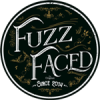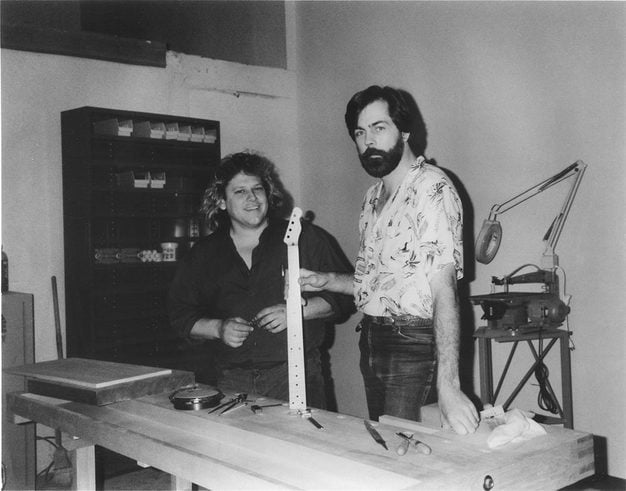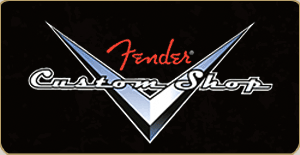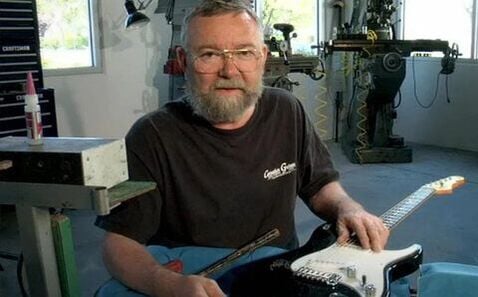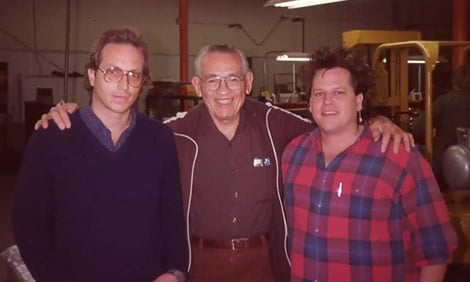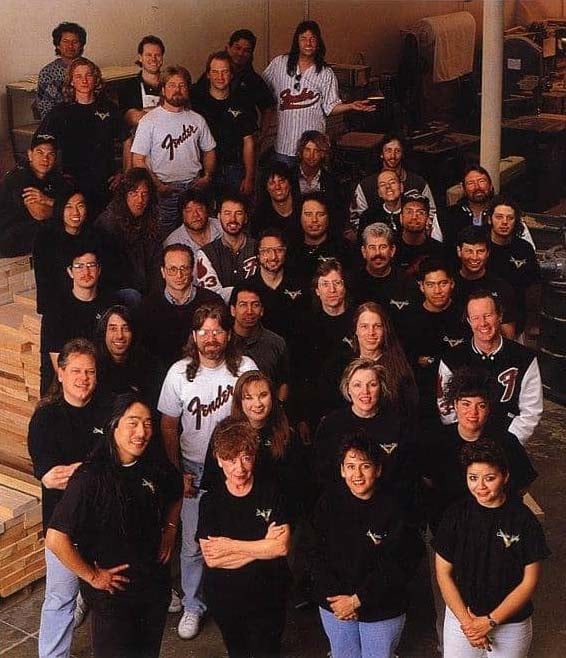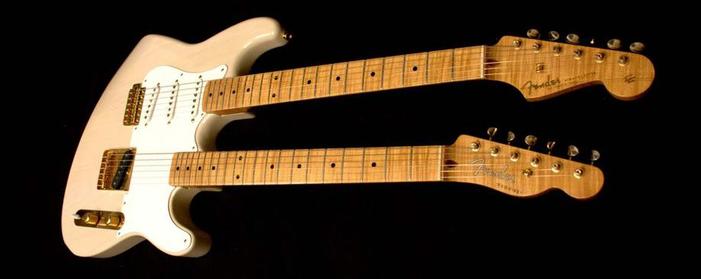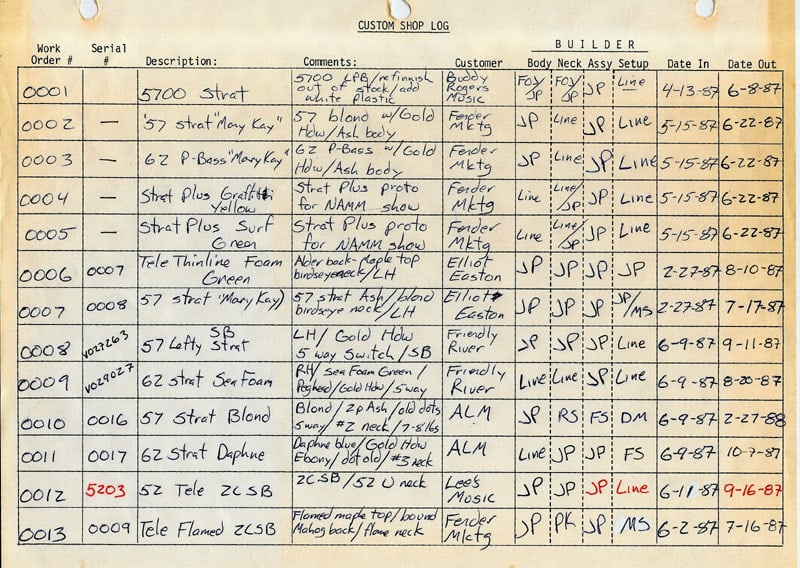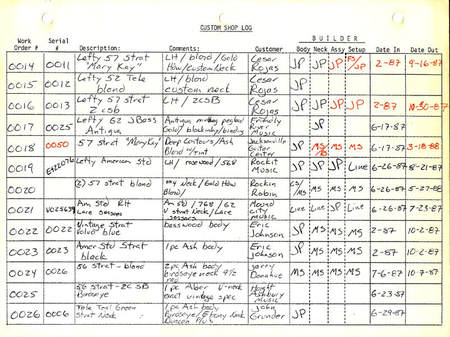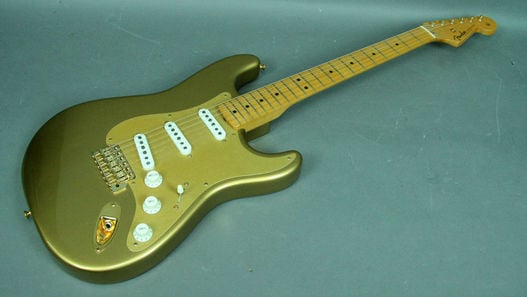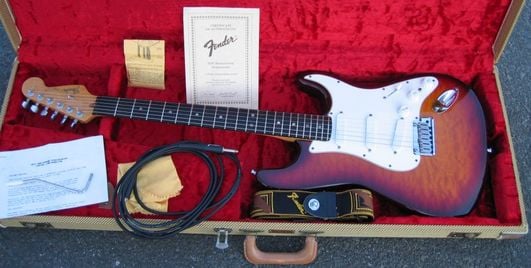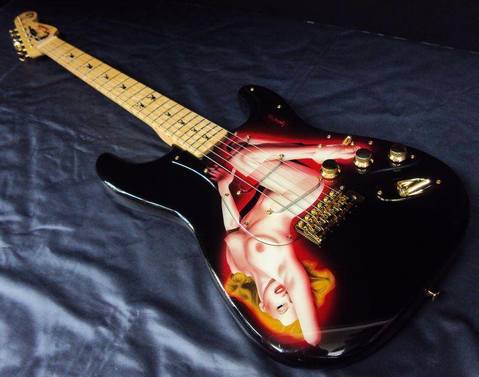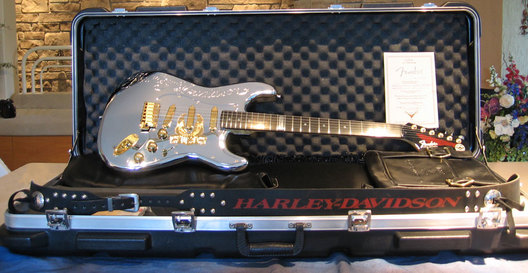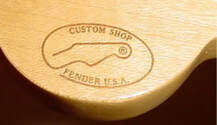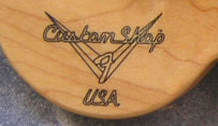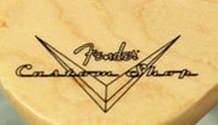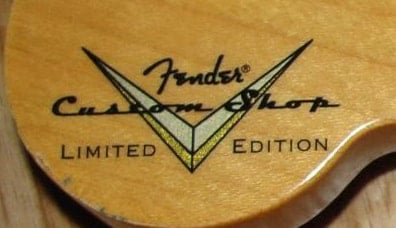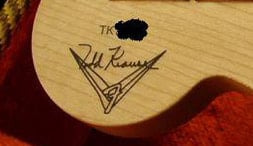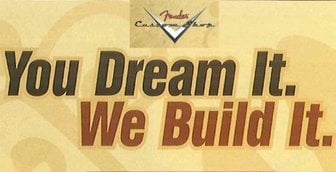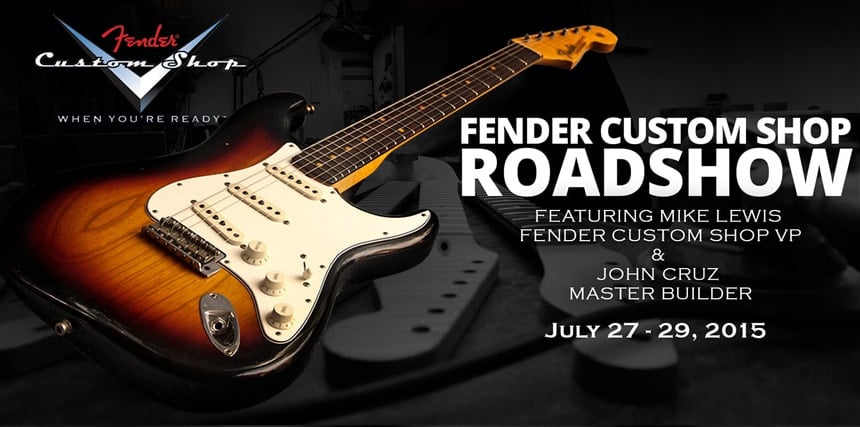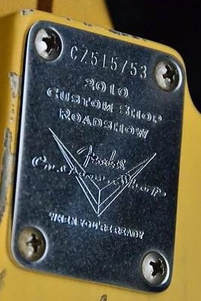CUSTOM SHOP ORIGINS
|
The original purpose of Fender Custom Shop, which officially opened on 15th May 1987, was to make special, or custom instruments mainly for famous artists or working musicians. A sort of ‘best-of-the-best’ department, where top-level luthiers would craft the finest renditions of both traditional Fender models and new cutting-edge designs.
|
At that time, the "custom" concept was not totally new. In fact, custom guitars, like Eldon Shamblin’s Gold Stratocaster or Bill Carson’s Cimarron Red Stratocaster, were built also in the ‘50s, but the Custom Shop ‘as we know it’ has roots going back to the early to mid-'80s. At that time, Fender Research and Development department had many very talented minds and craftsmen that had proven themselves with the success of the Vintage Reissue project. John Page, Steve Boulanger, Scott Zimmerman, and John Cermenaro started talking to each other about their desire to make custom instruments, laying the foundations of the Custom Shop. John Page actually wrote up a formal proposal with all details and presented it in writing to Bill Schultz in 1984. The specific structure of what they proposed was essentially exactly what was the Fender Custom Shop in the early days, minus one important point: it should be independent of Fender. The idea was to have some sort of separate and independent operation limited to building special and prestigious instruments for important musicians that would elevate the Fender brand’s value in the marketplace. Unfortunately, CBS rejected their original proposal.
However, by then the Custom Shop seeds had been sown. In fact, Dan Smith said: “We were only going to make 10 Vintage pieces a day, so we were going to start a Custom Shop to build special projects for artists, to make certain that the prestige was still there for the company.” Dan didn’t really mind if the Custom Shop didn’t make money, it was all about promoting the prestige of the Fender brand.
However, by then the Custom Shop seeds had been sown. In fact, Dan Smith said: “We were only going to make 10 Vintage pieces a day, so we were going to start a Custom Shop to build special projects for artists, to make certain that the prestige was still there for the company.” Dan didn’t really mind if the Custom Shop didn’t make money, it was all about promoting the prestige of the Fender brand.
|
The first choice to head up the Custom Shop was John Carruthers, one of the first people hired (as a consultant) by Bill Schultz when he took over at CBS Fender. John was a famous luthier who customized and repaired instruments for some of the most important musicians. Although he was a close friend of Dan Smith, he decided to reject the offer because he had established his own business with many professional clients.
|
|
So, Smith suggested to Bill Schultz to tap the designer, engineer, and guitar builder George Blanda to head up a small Custom Shop and make artist guitars. “I had a business building guitar,” said George. “Prior to that I had a couple of years experience working at Ax-In-Hand in DeKalb, Illinois, so I had seen a great many vintage guitars.
Within a couple of months after the buyout, they weren’t really sure what they were going to do, but they had determined that they were going to start a Custom Shop, and that would be a good place for me.” |
George joined Fender in October 1985, but that Custom Shop project was temporarily back-burner because Yen/US Dollar exchange rates began to favor exports, and demand for US-made products increased dramatically. “When the yen dropped, prices of Japanese products went way up overnight,” George said. “So, importing them wasn’t going to save us as much money. Besides, everybody wanted to see some good old-fashioned US technology again.” Fender needed an R&D specialist to come up with new models, and the job fell to Blanda.
So, Dan Smith discussed the idea with guitar makers Michael Stevens, and also with John Page, who had left the company a year earlier to concentrate on his music.
Michael Stevens was a guitar maker who had begun his career in 1967, working with the late Larry Jameson at the famed Guitar Resurrection in San Francisco, California. In 1978, he opened his own workshop in Austin, where he repaired and built guitars for many important musicians, such as the Vaughan brothers, Albert King, Eric Johnson, Otis Rush, and Lonnie Mack.
Unlike Michael Stevens, John Page had already worked at Fender by the time the Custom Shop was a vague concept. He initially started working at Fender in 1978, at age of 21, and spent close to nine years in Guitar R&D – three as a model maker and six as a guitar design engineer with Freddie Tavares. He had left Fender at the end of January 1986 to spend the year in the studio working on his music, although he did some design consulting for Fender as well, but after 11 months he had returned: “I called Dan Smith in December of 1986 to tell him I was going to get back in the guitar industry and asked him if they had any openings at Fender,” John declared. “He said that I could have my choice – get back into guitar R&D or get in on the ground floor of the Custom Shop. I really didn’t have any desire to get back into R&D (I didn’t get along very well with the guy in charge), but I liked the idea of the Custom Shop. Back when I was in the model shop, we made custom guitars for artists all the time. Fender just didn’t advertise it. In fact, John Cermenaro, Steve Boulanger and Scott Zimmerman, and myself put together a proposal for us to start a Custom Shop as outside vendors, back in 1984 -1985. The proposal was rejected by CBS management.”
So, Dan Smith discussed the idea with guitar makers Michael Stevens, and also with John Page, who had left the company a year earlier to concentrate on his music.
Michael Stevens was a guitar maker who had begun his career in 1967, working with the late Larry Jameson at the famed Guitar Resurrection in San Francisco, California. In 1978, he opened his own workshop in Austin, where he repaired and built guitars for many important musicians, such as the Vaughan brothers, Albert King, Eric Johnson, Otis Rush, and Lonnie Mack.
Unlike Michael Stevens, John Page had already worked at Fender by the time the Custom Shop was a vague concept. He initially started working at Fender in 1978, at age of 21, and spent close to nine years in Guitar R&D – three as a model maker and six as a guitar design engineer with Freddie Tavares. He had left Fender at the end of January 1986 to spend the year in the studio working on his music, although he did some design consulting for Fender as well, but after 11 months he had returned: “I called Dan Smith in December of 1986 to tell him I was going to get back in the guitar industry and asked him if they had any openings at Fender,” John declared. “He said that I could have my choice – get back into guitar R&D or get in on the ground floor of the Custom Shop. I really didn’t have any desire to get back into R&D (I didn’t get along very well with the guy in charge), but I liked the idea of the Custom Shop. Back when I was in the model shop, we made custom guitars for artists all the time. Fender just didn’t advertise it. In fact, John Cermenaro, Steve Boulanger and Scott Zimmerman, and myself put together a proposal for us to start a Custom Shop as outside vendors, back in 1984 -1985. The proposal was rejected by CBS management.”
The first years
|
At first only Senior Design Engineer (the "master builder" term had not yet been coined) Michael Stevens, with the assistance of John Page, worked at the Shop.
Soon, however, Michael and John alone were no longer enough. At first Richard Syarto, who remained only until April 20, 1989, and Fred Stuart came, but others followed, like Art Esparza, Scott Buehl, John English, J.W. Black, Jason Davis, Larry Brooks, Yasuhiko Iwanade, Steve Boulanger, Greg Fessler, Pamelina Hovnatanian. Later it was the turn of Todd Krause, Mark Kendrick, Mike Ponce, Alan Hamel, George Amicay, Stephen Stern, Gene Baker, Abigail Ybarra, John Cruz and John Suhr. |
The outcome was the realization of so many new Fender models that it’s impossible to catalog all the guitars made since 1987.
Many Custom Shop instruments were assembled, especially at the beginning, using “factory” components. Some steps of instrument production could be completed in the Custom Shop, others in the factory. And until the Custom Shop had its own finishing department, almost all the models were painted in the Fender factory: “The Shop wasn't a separate institution. It was a moving, flowing process, never in stone. We worked with the factory people all the time, and they helped us all the time as well. If it weren't for manufacturing, we could not have built one-offs,” as J. Black remembers. At the same time, however, the two master builders required more attention compared to the “factory”: “I needed exact climate control, day and night. I also wanted our own separate wood stock, and a very specific set of tools,” Stevens declared in an interview.
But the Custom Shop wasn’t only this: it was also Fender nerve center of research and experimentation, where new production techniques were developed and new machinery tested, eventually to be used also in the factory production, thus bringing the quality of Fender guitars to a higher level. Many models born in the Custom Shop, like many signatures, were subsequently transferred to the factory production. But the contrary could also be true: factory models could be reworked and perfected in the Custom Shop. Besides this, Michael Stevens said it had another role: “Preserve Fender History”.
Although the original idea was to promote the prestige of the brand more than being entirely motivated by profit, the success of the Custom Shop was such that, in no time, it was used for the development of limited edition guitars for the general public or, with the introduction of the price list in 1992, for the production of custom series, thus becoming an important source of income for Fender.
Many Custom Shop instruments were assembled, especially at the beginning, using “factory” components. Some steps of instrument production could be completed in the Custom Shop, others in the factory. And until the Custom Shop had its own finishing department, almost all the models were painted in the Fender factory: “The Shop wasn't a separate institution. It was a moving, flowing process, never in stone. We worked with the factory people all the time, and they helped us all the time as well. If it weren't for manufacturing, we could not have built one-offs,” as J. Black remembers. At the same time, however, the two master builders required more attention compared to the “factory”: “I needed exact climate control, day and night. I also wanted our own separate wood stock, and a very specific set of tools,” Stevens declared in an interview.
But the Custom Shop wasn’t only this: it was also Fender nerve center of research and experimentation, where new production techniques were developed and new machinery tested, eventually to be used also in the factory production, thus bringing the quality of Fender guitars to a higher level. Many models born in the Custom Shop, like many signatures, were subsequently transferred to the factory production. But the contrary could also be true: factory models could be reworked and perfected in the Custom Shop. Besides this, Michael Stevens said it had another role: “Preserve Fender History”.
Although the original idea was to promote the prestige of the brand more than being entirely motivated by profit, the success of the Custom Shop was such that, in no time, it was used for the development of limited edition guitars for the general public or, with the introduction of the price list in 1992, for the production of custom series, thus becoming an important source of income for Fender.
|
After a couple of months spent in Michael's garage, the two luthiers moved to the Corona factory, in a small stretched room they called "bowling alley", which was enlarged as soon as Richard Syarto and Fred Stuart joined the Custom Shop. After a year, Fender added two more buildings on Pomona Avenue and the master builders moved to the fourth edifice.
On September 13, 1989 Fender assigned John Page the task of managing, besides the Custom Shop, the research and development department, starting an intense collaboration with experienced engineers of the caliber of Steve Boulanger and George Blanda (who had been hired to open the Custom Shop but was then delegated to other tasks): “By combining the computer and manufacturing capabilities of the R&D department with the artistry of the Custom Shop, John is heading Fender in the future with a bullet,” the Californian company announced. |
After a couple of months spent in Michael's garage, the two luthiers moved to the Corona factory, in a small stretched room they called "bowling alley", which was enlarged as soon as Richard Syarto and Fred Stuart joined the Custom Shop. After a year, Fender added two more buildings on Pomona Avenue and the master builders moved to the fourth edifice.
On September 13, 1989 Fender assigned John Page the task of managing, besides the Custom Shop, the research and development department, starting an intense collaboration with experienced engineers of the caliber of Steve Boulanger and George Blanda (who had been hired to open the Custom Shop but was then delegated to other tasks): “By combining the computer and manufacturing capabilities of the R&D department with the artistry of the Custom Shop, John is heading Fender in the future with a bullet,” the Californian company announced.
In 1990 Fender purchased two plants in a street adjacent to Pomona Avenue, first at 135, then at 1233 Enterprise Court. The Custom Shop was now placed both in the fourth building on Pomona and in those on Enterprise. John Page recalled that period with these words: “We were all pretty much in the same building, with very few walls. We were also physically separated from the factory, albeit only by a block or so. It allowed us to create our own environment, our own mood. [...] We got to the point where we brought in raw lumber, made our own bodies and necks, painted and buffed them, assembled them, made our own pickups and even our own straps, all under the same roof.” For some time the Custom Shop occupied both buildings on Enterprise Court, but soon left 135 in favor of a new plant attached to the 1233, just purchased by Fender, in Lewis Court.
As the Custom Shop expanded in structure and production, so it had to increase the staff. Since the second half of the '90s Louis Salgado, Dennis Galuszka, Yuriy Shishkov, Chris Fleming had joined Fender “dream factory”.
In 1997 Mike Eldred took the place of John Page as the head of the Custom Shop which, in 1998, moved to the new buildings in Cessna Circle.
At the beginning the first bodies used by Custom Shop luthiers were the same as those utilized by the factory, carefully selected, except for the maple boards (for the tops) that weren’t used for the factory production and were supplied by Bill Redman. In the '90s the Custom Shop began to make use of boards from the Westwood Lumber, in Oregon. Instead, many of the woods chosen for the figured maple necks (flame or bird’s eye) came from the Yankee Veneer Corp., in New Hampshire.
On September 13, 1989 Fender assigned John Page the task of managing, besides the Custom Shop, the research and development department, starting an intense collaboration with experienced engineers of the caliber of Steve Boulanger and George Blanda (who had been hired to open the Custom Shop but was then delegated to other tasks): “By combining the computer and manufacturing capabilities of the R&D department with the artistry of the Custom Shop, John is heading Fender in the future with a bullet,” the Californian company announced.
In 1990 Fender purchased two plants in a street adjacent to Pomona Avenue, first at 135, then at 1233 Enterprise Court. The Custom Shop was now placed both in the fourth building on Pomona and in those on Enterprise. John Page recalled that period with these words: “We were all pretty much in the same building, with very few walls. We were also physically separated from the factory, albeit only by a block or so. It allowed us to create our own environment, our own mood. [...] We got to the point where we brought in raw lumber, made our own bodies and necks, painted and buffed them, assembled them, made our own pickups and even our own straps, all under the same roof.” For some time the Custom Shop occupied both buildings on Enterprise Court, but soon left 135 in favor of a new plant attached to the 1233, just purchased by Fender, in Lewis Court.
As the Custom Shop expanded in structure and production, so it had to increase the staff. Since the second half of the '90s Louis Salgado, Dennis Galuszka, Yuriy Shishkov, Chris Fleming had joined Fender “dream factory”.
In 1997 Mike Eldred took the place of John Page as the head of the Custom Shop which, in 1998, moved to the new buildings in Cessna Circle.
At the beginning the first bodies used by Custom Shop luthiers were the same as those utilized by the factory, carefully selected, except for the maple boards (for the tops) that weren’t used for the factory production and were supplied by Bill Redman. In the '90s the Custom Shop began to make use of boards from the Westwood Lumber, in Oregon. Instead, many of the woods chosen for the figured maple necks (flame or bird’s eye) came from the Yankee Veneer Corp., in New Hampshire.
THE FIRST GUITARS
The first Custom Shop guitar made by Michael Stevens was a doubleneck strat/esquire that the master builder realized in the summer of 1987 for his friend Jimmy Wallace. The first Fender doubleneck in history, it exhibited on the neck plate of the Stratocaster the “0001” serial number and the dates written in pencil (6/18/87 e 6/19/87) together with the “MS” initials on the neck heels.
John Page considers his Mary Kaye Strat, on which Stevens collaborated too, built for his friend Elliot Easton, the very first Custom Shop guitar, as it was the first to leave the factory. The order, according to the notes of the master builder, was done on February 27, 1987. It was a ’57 style ash Stratocaster, blonde finished and with bird’s eye neck, “0008” as serial number, sent on July 17, 1987.
Actually, other five instruments had already left Fender, but John considered them “marketing's mix-and-match kind of stuff we had to do for shows, or the Japanese re-paint.” In fact, by analyzing John Page Custom Log Shop, a list, compiled for about a year and a half, in which the master builder noted down his work, we can deduce that the first Custom Shop guitars were Stratocasters required by Fender marketing to be promoted at NAMM, and a Stratocaster made in Japan that a store in Ohio, Buddy Roger's Music, asked to be refinished in Lake Placid Blue. Scrolling through the list, it is possible to note that among the customers of the first period of the Custom Shop there were famous musicians, like Eric Johnson, Jerry Donahue and Cesar Rosas.
Actually, other five instruments had already left Fender, but John considered them “marketing's mix-and-match kind of stuff we had to do for shows, or the Japanese re-paint.” In fact, by analyzing John Page Custom Log Shop, a list, compiled for about a year and a half, in which the master builder noted down his work, we can deduce that the first Custom Shop guitars were Stratocasters required by Fender marketing to be promoted at NAMM, and a Stratocaster made in Japan that a store in Ohio, Buddy Roger's Music, asked to be refinished in Lake Placid Blue. Scrolling through the list, it is possible to note that among the customers of the first period of the Custom Shop there were famous musicians, like Eric Johnson, Jerry Donahue and Cesar Rosas.
Many other instruments joined these, like other Mary Kaye Strats, five hundred HLE Stratocasters (“HLE” standing for "Haynes Limited Edition") inspired by the “tri-gold” Stratocaster (gold finish and hardware and anodized brass pickguard), built in the late 1950s for Homer Haynes, member of the Homer & Jethro duo, and five hundred 35th Anniversary Stratocaster.
For a period also some guitars similar to the Stratocasters were made, the Subsonics, with the characteristic BEADGB tuning, equipped with fixed bridge and whose scale was 27". Most of the time the first instruments were reissues of the guitars of the past: the factory reissues didn’t replicate the old Stratocasters specs too faithfully – rather, they commemorated them. However, the musicians who, fascinated by vintage, asked the Custom Shop for more faithful replicas, were many. For this reason the contribution of Michael Stevens, a profound connoisseur and meticulous scholar of Leo's guitars, was very important.
ART GUITARS AND THE DIAMOND DEALERS
At the beginning of the '90s the Custom Shop began to develop new one-off models, nicknamed Art Guitars, that elevated Fender to an artistic level, in reference to which should not been forgotten the contribution, in particular, of Pamelina Hovnatanian’s and "master carver" George Amicay’s drawings, as well as that of John Page, John English, Fred Stuart, Alan Hamel and J.W.Black. Thanks to these instruments the Custom Shop became just as Bill Schultz wanted it: not a simple hand-made guitars factory, but a real laboratory of custom-made or collectible Fender instruments, authentic artworks, to be placed side by side with the normal production.
|
Anything could be created: Stratocasters with aluminum body, others with ebony fretboard or maple top or with set-neck instead of bolt-on neck, different number of pickups, diamond inlays, anodized or engraved aluminum pickguards.
Whatever one dreamed of, could be done in the Corona Custom Shop, and that’s why it deserved the nickname of Dream Factory. Among the first Art Guitars, the 109 Harley Davidson 90th Anniversary Stratocasters, with a very special aluminum body, or the 175 40th Anniversary Playboy Strats should be remembered. |
Some of these were sold by a limited number of dealers, selected by Bill Schultz and Jack Shelton, senior vice president of sales, and could be recognized by a small diamond set on the headstock: the Diamond Dealers.
Though they had been always made in the Custom Shop, the term "Art Guitars" appeared for the first time in the Fender catalog in 2005. While in the past the master builders collaborated with the “graphic artists” by assigning a specific task to a single specialist (a carver, an inlay or engraving expert, a painter, etc.), now Fender gave the artist a whole body or neck to be worked, sometimes giving him carte blanche. The result was more complex and elaborate, as well as being more uniform. Among these artists, Dave Newman, Sara Ray, Nevena Christie, Kit Carson, Joe Wood, Dan Lawrence, Ron Thorn, Kid Ramos, Shag, Dennis McPhail e Kristen Easthope, in addition to the ever-present Pamelina H. and George Amicay, should be remembered.
MASTER BUILT AND TEAM BUILT
In the first half of the '90s, the need to switch to a new idea of the Custom Shop, an idea different from the original one because it was envisioned primarily for the prestige of Fender and not for the profit, became more stringent, because it could not have survived much longer without profit. It then became necessary to look towards the general public.
The introduction of the price list in 1992 was the first step in this direction. But also production had to be increased. So Mike Lewis, John Page and Mike Eldred began to work together to decide how redesign the Custom Shop, whose production was divided in Team Built and Master Built.
The Team Built (or Custom Built as it was sometimes called since 2008) consisted of instruments made by a selected number of apprentices, under the supervision of a master builder, consisting of a few main luthiers of the Californian company, who would also give the final approval: “They're a small group of really talented craftsman who build some of the Custom Shop "catalog" guitars,” Yuriy Shishkov explained. In fact the Team Built guitars can be found in the Fender Frontline magazines, cataloged in series containing the specs most commonly requested by guitarists.
“With a Master Built, you are getting the highest level of craftsmanship Fender,” Jason Smith simply stated. The Master Built were Fender flagship guitars, unique models, born from master builder’s imagination or at a specific request by a guitarist or dealer. When a master builder was promoted to senior master builder, besides continuing to produce his own guitars, he also took on the role of manager, and consequently created relationships between Fender and his customers, dealt with deadlines in production and proposed new ideas – in other words, he took on new assignments and new responsibilities.
The introduction of the price list in 1992 was the first step in this direction. But also production had to be increased. So Mike Lewis, John Page and Mike Eldred began to work together to decide how redesign the Custom Shop, whose production was divided in Team Built and Master Built.
The Team Built (or Custom Built as it was sometimes called since 2008) consisted of instruments made by a selected number of apprentices, under the supervision of a master builder, consisting of a few main luthiers of the Californian company, who would also give the final approval: “They're a small group of really talented craftsman who build some of the Custom Shop "catalog" guitars,” Yuriy Shishkov explained. In fact the Team Built guitars can be found in the Fender Frontline magazines, cataloged in series containing the specs most commonly requested by guitarists.
“With a Master Built, you are getting the highest level of craftsmanship Fender,” Jason Smith simply stated. The Master Built were Fender flagship guitars, unique models, born from master builder’s imagination or at a specific request by a guitarist or dealer. When a master builder was promoted to senior master builder, besides continuing to produce his own guitars, he also took on the role of manager, and consequently created relationships between Fender and his customers, dealt with deadlines in production and proposed new ideas – in other words, he took on new assignments and new responsibilities.
FENDER CUSTOM SHOP LOGO
On the back of the headstock of the Fender Stratocasters made in the Custom Shop, two types of logo were used: one oval, with a stylized headstock, the "CUSTOM SHOP FENDER U.S.A." decal; the other, designed to distinguish the instruments built by a single luthier, included his signature and the "CUSTOM-BUILT FENDER U.S.A." decal.
The oval logo was simple and elegant, but according to John Page it was too similar to the logo already used by the Japanese Custom Shop; so he commissioned Pamelina H. to design a new symbol. The outcome was a logo that, in full Fender spirit, remembered the old emblem of a car manufacturer, the Chevrolet. At first the new V logo sported the letter “F”, but in the late '90s Bill Schultz decided to replace it with the word “Fender”. Obviously, if the guitar was made by a master builder, his signature joined the logo. During the years, some variants of the V logo appeared, like those which included the "LIMITED EDITION" or "WHEN YOU'RE READY" decals.
CUSTOM AND LIMITED COLLECTIONS
The Limited Release Series and Limited Edition Series terms began appearing in the catalogs of the new millennium in addition to the already discussed Tribute, Master Design, Builder Select and Art Guitars.
The Limited Release Series referred to the instruments of the Custom Shop that, for their characteristics, represented a turning point or an innovation for Fender. They were then prototypes or “test market guitars”. Given their limited number, they were destined to become collectibles.
The Limited Release Series referred to the instruments of the Custom Shop that, for their characteristics, represented a turning point or an innovation for Fender. They were then prototypes or “test market guitars”. Given their limited number, they were destined to become collectibles.
|
The Limited Release term was used for the 2004 '54 Anniversary Stratocaster, but later it was replaced by the Limited Edition one.
The Limited Edition Series included all those models made only for a short time by the Custom Shop before being definitively withdrawn. In this case we are also dealing with objects of important collectible value. |
In 2008, however, the Limited Edition and Limited Relase terms gradually began to be replaced by the Limited Collection one. The essence did not change. This series included all the very short edition guitars of the Custom Shop, but from a marketing and communication point of view it represented a turning point: “We don't want a catalog,” Mike Eldred explained. “We have collections. We get ideas from artists, other players, Master Builders and dealers, and we put together guitars with the coolest, most versatile features.”
At the same time, at the beginning of each year Fender started to offer also a certain number of Custom Collection guitars that were parts of the various Custom Shop series and were produced only for a year or so. After that they were no longer available and the company moved on to the next model.
The Limited Edition term was not completely abandoned, and Fender continued to use it to indicate some Stratocasters, like the Black1 tribute or the 2010 Limited Eric Clapton Signature Stratocaster.
At the same time, at the beginning of each year Fender started to offer also a certain number of Custom Collection guitars that were parts of the various Custom Shop series and were produced only for a year or so. After that they were no longer available and the company moved on to the next model.
The Limited Edition term was not completely abandoned, and Fender continued to use it to indicate some Stratocasters, like the Black1 tribute or the 2010 Limited Eric Clapton Signature Stratocaster.
FENDER ROADSHOW
The Roadshow is an itinerant event during which Fender Musical Instruments representatives and some Master Builders display and present a selection of extremely rare instruments of the Custom Shop. Furthermore, during the event, it is possible to admire Fender historical luthiers in action: shaping the neck, mounting tuning machines, bridges or frets, or applying the decals. It is also an occasion to meet, in person, your own preferred Master Builder and ask for advice, design an instrument, or see one born before your eyes.
Custom Classic, Set-neck and Contemporary
Art of relic: the Cunetto Era
Time Machine and Vintage Custom Series
Master Design, Builder Select, Founders Design, Dealer Select Series
Stratocaster Pro, Proto Strat, Postmodern Series
Custom Deluxe, American Custom, Artisan Series
The anniversary of the Custom Shop
Art of relic: the Cunetto Era
Time Machine and Vintage Custom Series
Master Design, Builder Select, Founders Design, Dealer Select Series
Stratocaster Pro, Proto Strat, Postmodern Series
Custom Deluxe, American Custom, Artisan Series
The anniversary of the Custom Shop
Antonio Calvosa
